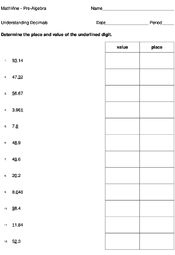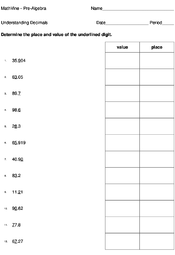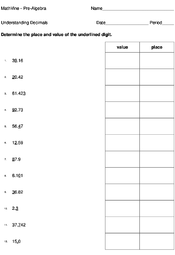Understanding Decimals
Introduction
The decimal system is used to express numbers that are not whole numbers. Any number can be written in decimal notation, and decimals can be added, subtracted, multiplied, and divided just like any other number.
Terms
Lesson
Any real number can be written as a decimal. The whole number 3 for example, can be written as
, etc.,
Decimal Place Value Chart
Millions | Hundred Thousands | Ten Thousands | Thousands | Hundreds | Tens | Ones | Decimal Point | Tenths | Hundredths | Thousandths | Ten-thousandths | Hundred Thousandths | Millionths |
|---|---|---|---|---|---|---|---|---|---|---|---|---|---|
| 3 | . | ||||||||||||
| 3 | . | ||||||||||||
| 3 | . | ||||||||||||
| 3 | . |
although the trailing zeroes are usually ignored. Anything other than zero after the decimal point means that the number is not whole. 3.52, for example, is a number between 3 and 4. The first space after the decimal is referred to as the “tenths” place, the next space is known as the “hundreths” place, the third space is the “thousandths” place, etc.
Note: Just like it is acceptable to add zeroes at the end of decimals (0.5 can be written as 0.50 or 0.500) it is also acceptable to omit zeroes as long as they are after the decimal point and not followed by further numbers (1.30 can be written as 1.3).


